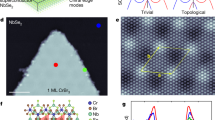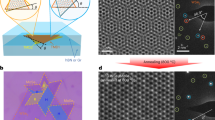Abstract
Two-dimensional superconductor (2DSC) monolayers with non-centrosymmetry exhibit unconventional Ising pair superconductivity and an enhanced upper critical field beyond the Pauli paramagnetic limit, driving intense research interest. However, they are often susceptible to structural disorder and environmental oxidation, which destroy electronic coherence and provide technical challenges in the creation of artificial van der Waals heterostructures (vdWHs) for devices. Herein, we report a general and scalable synthesis of highly crystalline 2DSC monolayers via a mild electrochemical exfoliation method using flexible organic ammonium cations solvated with neutral solvent molecules as co-intercalants. Using NbSe2 as a model system, we achieved a high yield (>75%) of large-sized single-crystal monolayers up to 300 µm. The as-fabricated, twisted NbSe2 vdWHs demonstrate high stability, good interfacial properties and a critical current that is modulated by magnetic field when one flux quantum fits to an integer number of moiré cells. Additionally, formulated 2DSC inks can be exploited to fabricate wafer-scale 2D superconducting wire arrays and three-dimensional superconducting composites with desirable morphologies.
This is a preview of subscription content, access via your institution
Access options
Access Nature and 54 other Nature Portfolio journals
Get Nature+, our best-value online-access subscription
$29.99 / 30 days
cancel any time
Subscribe to this journal
Receive 12 print issues and online access
$259.00 per year
only $21.58 per issue
Buy this article
- Purchase on Springer Link
- Instant access to full article PDF
Prices may be subject to local taxes which are calculated during checkout




Similar content being viewed by others
Data availability
The datasets generated during the current study are available from the corresponding author on request.
References
Saito, Y., Nojima, T. & Iwasa, Y. Highly crystalline 2D superconductors. Nat. Rev. Mater. 2, 16094 (2016).
Xu, X., Yao, W., Xiao, D. & Heinz, T. F. Spin and pseudospins in layered transition metal dichalcogenides. Nat. Phys. 10, 343–350 (2014).
Xi, X. et al. Strongly enhanced charge-density-wave order in monolayer NbSe2. Nat. Nanotechnol. 10, 765–769 (2015).
Li, L. J. et al. Controlling many-body states by the electric-field effect in a two-dimensional material. Nature 529, 185–189 (2015).
Qin, S., Kim, J., Niu, Q. & Shih, C.-K. Superconductivity at the two-dimensional limit. Science 324, 1314–1317 (2009).
Geim, A. K. & Grigorieva, I. V. Van der Waals heterostructures. Nature 499, 419–425 (2013).
Liu, Y. et al. Van der Waals heterostructures and devices. Nat. Rev. Mater. 1, 16042 (2016).
Ugeda, M. M. et al. Characterization of collective ground states in single-layer NbSe2. Nat. Phys. 12, 92–97 (2015).
Joe, Y. I. et al. Emergence of charge density wave domain walls above the superconducting dome in 1T-TiSe2. Nat. Phys. 10, 421–425 (2014).
Xi, X. et al. Ising pairing in superconducting NbSe2 atomic layers. Nat. Phys. 12, 139–143 (2015).
Ge, J.-F. et al. Superconductivity above 100 K in single-layer FeSe films on doped SrTiO3. Nat. Mater. 14, 285–289 (2014).
Saito, Y., Kasahara, Y., Ye, J., Iwasa, Y. & Nojima, T. Metallic ground state in an ion-gated two-dimensional superconductor. Science 350, 409–413 (2015).
Graybeal, J. M. & Beasley, M. R. Localization and interaction effects in ultrathin amorphous superconducting films. Phys. Rev. B 29, 4167–4169 (1984).
Jaeger, H. M., Haviland, D. B., Orr, B. G. & Goldman, A. M. Onset of superconductivity in ultrathin granular metal films. Phys. Rev. B 40, 182–196 (1989).
Hebard, A. F. & Paalanen, M. A. Magnetic-field-tuned superconductor-insulator transition in two-dimensional films. Phys. Rev. Lett. 65, 927–930 (1990).
Zhou, J. et al. A library of atomically thin metal chalcogenides. Nature 556, 355–359 (2018).
Wang, H. et al. High-quality monolayer superconductor NbSe2 grown by chemical vapour deposition. Nat. Commun. 8, 394 (2017).
Lin, H. et al. Growth of environmentally stable transition metal selenide films. Nat. Mater. 18, 602–607 (2019).
Cai, X., Luo, Y., Liu, B. & Cheng, H.-M. Preparation of 2D material dispersions and their applications. Chem. Soc. Rev. 47, 6224–6266 (2018).
Han, J. H., Kwak, M., Kim, Y. & Cheon, J. Recent advances in the solution-based preparation of two-dimensional layered transition metal chalcogenide nanostructures. Chem. Rev. 118, 6151–6188 (2018).
Peng, J. et al. Very large-sized transition metal dichalcogenides monolayers from fast exfoliation by manual shaking. J. Am. Chem. Soc. 139, 9019–9025 (2017).
Cullen, P. L. et al. Ionic solutions of two-dimensional materials. Nat. Chem. 9, 244–249 (2017).
Lin, Z. et al. Solution-processable 2D semiconductors for high-performance large-area electronics. Nature 562, 254–258 (2018).
Zeng, Z. et al. Single-layer semiconducting nanosheets: high-yield preparation and device fabrication. Angew. Chem. Int. Ed. Engl. 50, 11093–11097 (2011).
Watts, M. C. et al. Production of phosphorene nanoribbons. Nature 568, 216–220 (2019).
Chen, P. et al. Charge density wave transition in single-layer titanium diselenide. Nat. Commun. 6, 8943 (2015).
Yu, Y. et al. Gate-tunable phase transitions in thin flakes of 1T-TaS2. Nat. Nanotechnol. 10, 270–276 (2015).
Tsen, A. W. et al. Nature of the quantum metal in a two-dimensional crystalline superconductor. Nat. Phys. 12, 208–212 (2015).
Fiory, A. T. & Hebard, A. F. Electron mobility, conductivity, and superconductivity near the metal-insulator transition. Phys. Rev. Lett. 52, 2057–2060 (1984).
Lu, J. M. et al. Evidence for two-dimensional Ising superconductivity in gated MoS2. Science 350, 1353–1357 (2015).
Li, Q., Zhou, Q., Shi, L., Chen, Q. & Wang, J. Recent advances in oxidation and degradation mechanisms of ultrathin 2D materials under ambient conditions and their passivation strategies. J. Mater. Chem. A 7, 4291–4312 (2019).
Cao, Y. et al. Quality heterostructures from two-dimensional crystals unstable in air by their assembly in inert atmosphere. Nano Lett. 15, 4914–4921 (2015).
Khestanova, E. et al. Unusual suppression of the superconducting energy gap and critical temperature in atomically thin NbSe2. Nano Lett. 18, 2623–2629 (2018).
Hanlon, D. et al. Liquid exfoliation of solvent-stabilized few-layer black phosphorus for applications beyond electronics. Nat. Commun. 6, 8563 (2015).
Li, J. et al. Ultrafast electrochemical expansion of black phosphorus toward high-yield synthesis of few-layer phosphorene. Chem. Mater. 30, 2742–2749 (2018).
Kretinin, A. et al. Electronic properties of graphene encapsulated with different two-dimensional atomic crystals. Nano Lett. 14, 3270–3276 (2014).
Brown, R. & Garland, J. Effect of magnetic-field-induced frustration on the superconducting transition of proximity-coupled arrays. Phys. Rev. B 33, 7827 (1986).
Teitel, S. & Jayaprakash, C. Josephson-junction arrays in transverse magnetic fields. Phys. Rev. Lett. 51, 1999 (1983).
Shih, W. & Stroud, D. Two-dimensional superconducting arrays in a magnetic field: effects of lattice structures. Phys. Rev. B 32, 158 (1985).
Bonaccorso, F., Bartolotta, A., Coleman, J. N. & Backes, C. 2D-crystal-based functional inks. Adv. Mater. 28, 6136–6166 (2016).
Macdonald, E. et al. 3D printing for the rapid prototyping of structural electronics. IEEE Access 2, 234–242 (2014).
Klemm, R. A., Luther, A. & Beasley, M. Theory of the upper critical field in layered superconductors. Phys. Rev. B 12, 877 (1975).
Acknowledgements
J.Lu acknowledges support from MOE grants (MOE2017-T2-1-056 and MOE2019-T2-2-044) and NRF-CRP Grant (NRFCRP16-2015-02). J.Li acknowledges support from the National Natural Science Foundation of China (21703143). J.D. thanks NRF-CRP16-2015-01 (R284-000-159-281) for support of the 3D printing work. J.H.T. acknowledges support from Agency for Science, Technology and Research (A*STAR) under grant no. 1527000014. This work was supported by the National Research Foundation of Singapore under its Medium-Sized Centre Programme.
Author information
Authors and Affiliations
Contributions
J.Lu supervised the project. J.Li, K.S.N. and J.Lu conceived the research and wrote the paper. J.Li and Z.L. performed the cathodic intercalation and exfoliation experiment. P.S. and J.Li. fabricated the Hall bar and vdWHs device. P.S. carried out the low-temperature transport measurement of Hall bar devices and analysed the results. J.Z. and K.V. performed the low-temperature transport measurement of twisted NbSe2 vdWH devices and analysed the results. X.Z. performed the STEM imaging of exfoliated layered sheets and analysis. Z.Q. assisted with the STM imaging of TBA- and TPA-intercalated NbSe2 structures. Z.W. and L.L. fabricated and measured the twisted NbSe2 devices from mechanically exfoliated NbSe2. M.Z. performed inkjet printing of superconducting wires. Y.Z. and W.J. carried out the 3D printing. T.S.H. assisted with the superconductivity measurement of 2D and 3D printing structures. J.Li performed the TEM, AFM and Raman characterization. W.Y., X.H., P.L., H.X., H.Y., C.C., S.J.P., J.D., J.T. and A.H.C.N discussed and commented on the manuscript.
Corresponding authors
Ethics declarations
Competing interests
The authors declare no competing interests.
Additional information
Publisher’s note Springer Nature remains neutral with regard to jurisdictional claims in published maps and institutional affiliations.
Supplementary information
Supplementary Information
Supplementary Figs. 1–36, Table 1 and supporting information.
Rights and permissions
About this article
Cite this article
Li, J., Song, P., Zhao, J. et al. Printable two-dimensional superconducting monolayers. Nat. Mater. 20, 181–187 (2021). https://doi.org/10.1038/s41563-020-00831-1
Received:
Accepted:
Published:
Issue Date:
DOI: https://doi.org/10.1038/s41563-020-00831-1
This article is cited by
-
Metal telluride nanosheets by scalable solid lithiation and exfoliation
Nature (2024)
-
Interplay between the atomic structures and superconductivity of two-monolayer Pb films
Science China Physics, Mechanics & Astronomy (2024)
-
Recent advances on liquid intercalation and exfoliation of transition metal dichalcogenides: From fundamentals to applications
Nano Research (2024)
-
Synthesis of atomically thin sheets by the intercalation-based exfoliation of layered materials
Nature Synthesis (2023)
-
Electrochemical molecular intercalation and exfoliation of solution-processable two-dimensional crystals
Nature Protocols (2023)



